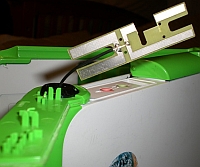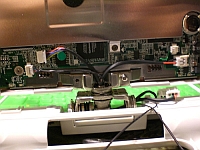Kids that I know, for instance in that picture, sleep with their laptop. I mean, they're not going to let these break, and Mary Lou Jepsen's done a heck of a job in making them very repairable, so that 95% of the maintenance is done by the kids, actually.Now reading that you might think that the OLPC XO is a modular computer, with each internal component easily repaired by children and the whole machine reassembled with a screwdriver and a smile. Even Walter Bender agrees with Ethan Zuckerman that the X0 is screwdriver repairable in their Radio Open Source interview:
Ethan: We don’t but by the way part of the beauty of the machine is that it is designed to be stripped down and taken apart. It’s one of the most wonderful things about it. The machine can be pulled apart with a screwdriver and in fact there is a lot of components that would be fun to use for other things. I think Walter would probably agree that that is actually a very positive outcome to come out of the machine, having people learn how to take these things apart and put them back together into different configurations.So you would expect that the XO computer could be easily taken apart, repaired, and reassembled by geeks. That's exactly what Jonah Bossewitch thought when he found his borrowed OLPC had power issues and could not demonstrate the Sugar user interface. Taking Negroponte and Bender at their word, he decided to try an OLPC field repair in the hope he could swap out motherboards and have a working computer again. His experience? Fixing a $100 laptop isn't as easy as it sounds:Walter: I absolutely agree, that is one of the beauties of making the machine be as open as possible.
I discovered that the OLPC hardware (at least at this stage) is not quite as easy to disassemble as one would hope - you really need more of a clean room than a Third-World repair shop to work on this model. Still, a few iconic cues directing disassembly, like on a Thinkpad or Apple, would go a long way.But what is the lesson we learn from Jonah's experience? The BTest-2 OLPC XO is not field-repairable by a competent techno-expert, which means that your average child in the developing world might be able to disassemble a production level X0 but would be hard pressed to repair or even reassemble a Children's Machine.In any case, I visually documented the disassembly process, but I don’t think I am going to be able to put humpty dumpty back together again any time soon. I guess I owe my friend $100 (well, now $150), since that is the list price of the OLPC.
So if students try their own field repair, as Negroponte hopes they do, teaches in participating countries could have Humpty Dumpty on a million unit scale: classrooms full of children and disassembled laptops, millions of dollars in technology in millions of pieces and parts.




I wonder what Jonah really was interested in when he took the antenna-ears apart in order to replace the mainboard.
Like all of us, Jonah eats the chocolate rabbit ears first.
A little light on the opening and repair of the XO (the photos are pretty, but they don't explain much)
First: it's a computer, so it has by definition some frail parts (the main board, for instance). Protecting them implies tucking them away, so that they are not exposed to blows and such
Second: getting the front cover out and access to the screen only takes 4 screws. The screen are 4 more, and the back cover another 4. Every ear has a couple, and the hinge, 2 for the plastic cover, 4 for the plastic piece on top of the battery and 8 for the metal piece. In total, around 26 screws, all unscrewable with the same model phillips screwdriver. Maybe boring (not so much with a little practice), but by no means complicated.
3. The screen only has 2 connections with the main board, and both are easily accessible. The main board has hust 8 connection points on the backside (2 for the ears, 4 comming through the hinge and 4 from the side). Again, boring, but not difficult.
And the best thing isn't that, but how the difficulty scales with the durability:
changing the battery takes (of course) seconds, the screen, 5 min max (those should be the main fracture points now that the ears are rubberized).
The hinge, maybe the least likely to break and the most difficult to change, takes around 30min.
When was the last time you opened your laptop and changed half the pieces? 'Cause that can be done with this one :D
I really like the hinge design, looks really sturdy. On my toshiba r15 tablet the open and close hinge is in the screen and it has a high resistance to moving so it can keep the weight of the screen up, unfortunately this puts a lot of strain on the lower part of the screen and I have heard of them breaking.
Good to the OLPC's hinge is built to last.
These pictures do suggest that the OLPC laptop might indeed be field reparable, but why hasn't the laptop crew opened up their hardware design along with their software?
Open sourcing the hardware means publishing the schematics, design, sizes and other information about the hardware - perhaps the assembly/disassembly instructions would organically emerge from such transparent efforts.
Instead, OLPC has been secretive and cagey about hardware distribution and specifications. What organizations are participating in their development program and what sorts of projects are they working on? I hear it is rather difficult for third parties to get their hands on an OLPC, other than a brief flirtation at a talk or a conference.
The hardware end of this project has been pretty far from the free and open ideals that the laptop foundation pays lip service too. I guess decades of working with DARPA, the DOD, and Fortune 500 companies rubs off on cultural attitudes, tendencies, and practices.
>> Maybe boring (not so much with a little practice), but by no means complicated.
Great. So, do you recommend practicing [un]screwing 26 screws many times, so it'll become less boring? Many people will find that logic to seem inverted :)
Negroponte said "I mean, they're not going to let these break, and Mary Lou Jepsen's done a heck of a job in making them very repairable, so that 95% of the maintenance is done by the kids, actually."
I don't buy that. Even with Quanta's extreme hard-core torture tests of the X0-1s there will be hardware-failures which aren't easily fixable. Especially since everything is so tightly integrated. You're really telling me that 95% of all failures are going be loose screws, because what else could these "spare parts" be that are said to be included with each laptop? Maybe a small IC or a spare CPU that children will be able to solder onto the PCB in case it breaks?
Interestingly the OLPC Wiki's list of replaceable components http://wiki.laptop.org/go/Support only lists these items: Directional Pad, Display, Keyboard, Antenna Ears. Are they going to be reponsible for 95% of the failures?
Another (unofficial) entry http://wiki.laptop.org/go/Ask_OLPC_a_Question_about_Product_Life-cycle says "The expectation is that each school will have a person who is capable of swapping out bad parts..."
Last piece of information about the whole topic can be found here: http://wiki.laptop.org/go/Laptop_Service_Programme_Ideas
Governments aren't buying Negroponte's foolishly optimistic hardware schedules either, as evidenced by the lack of orders. But make no mistake, Negroponte believes his magical machines will not only all work out of the box, but that they can and will be fixed by children themselves.
Hell, there isn't even a spare parts distribution plan: http://www.olpcnews.com/implementation/maintenance/no_spare_parts_distr.html